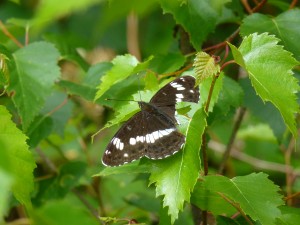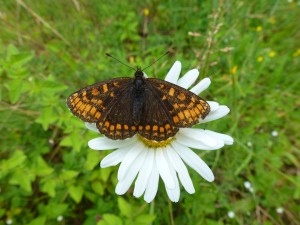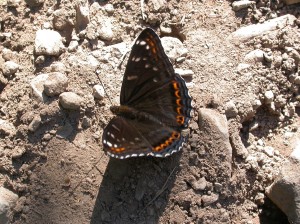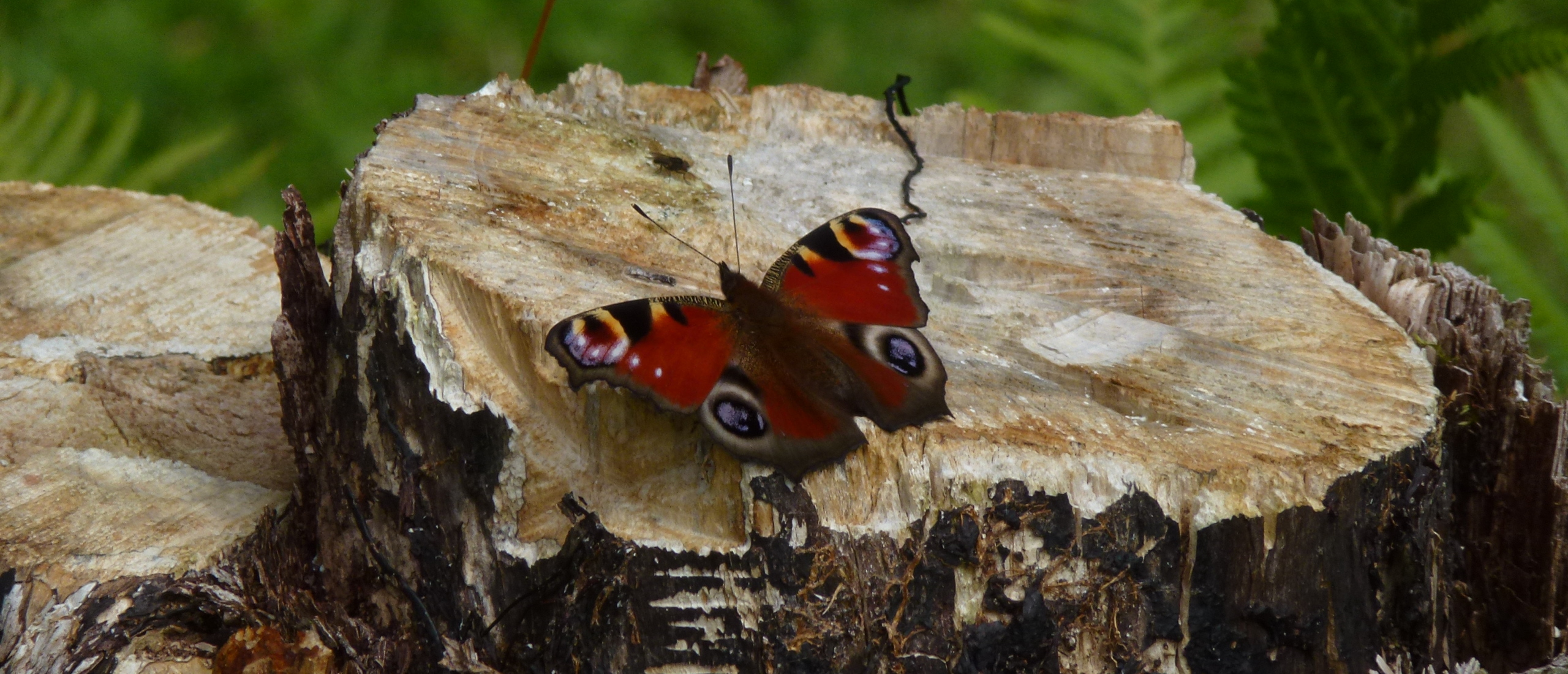
Butterfly of the Year! Last weekend was mainly involved with socialising with friends near Bonn, but I did drop by the juniper hills of Alendorf briefly on the way, adding Meadow Brown, Maniola jurtina, Small Skipper, Thymelicus sylvestris, and Ringlet, Aphantopus hyperanthus, but it was the Purple-edged Copper, Lycaena hippothoe, that I was particularly anxious to find, and sure enough, despite the strong wind, it was not long before I found a single male, resplendent with his burnished copper and purple sheen. I had feared that I would miss this species this year, so this was a worthwhile sighting, and I savoured the experience of watching this male's forays over the flower-filled meadow, always returning to approximately the same spot - male coppers are famously territorial, often pugnaciously seeing off much larger butterflies that venture into their domain.
 The purple edges can clearly be seen on this male Purple-edged Copper
The purple edges can clearly be seen on this male Purple-edged Copper
 The underside of the Purple-edged Copper is also attractive
The underside of the Purple-edged Copper is also attractive
This weekend has involved a certain degree of frustration, perhaps because we are now in the kind of lull between the main flush of Spring butterflies and the first emergence of the Summer species. I did nonetheless manage to add White Admiral, Limenitis camilla, of which there were impressive numbers on the wing. This species is always a pleasure to observe, with its elegant, gliding flight, and to see so many was a real treat - at one point I had at least 15 in view at the same time!
 This White Admiral has lost almost an entire hindwing
This White Admiral has lost almost an entire hindwing
The grassland areas were awash with Marbled Whites, Melanargia galathea, another attractive species, which despite its name is not a White at all, but a Brown!
 The Marbled White is in fact a Brown
The Marbled White is in fact a Brown
Fritillaries were quite numerous, with one False Heath Fritillary, Melitaea diamina, turning up on a flower-head, despite the cold on Saturday. This attractive butterfly now seems to have disappeared entirely from the areas where I used to see it in considerable numbers in my usual haunts in the forest in northern France, but here, close to the Meuse, it seems to be holding on.
 My one and only False Heath Fritillary (so far) this year
My one and only False Heath Fritillary (so far) this year
 False Heath Fritillaries seem to love white flowers
False Heath Fritillaries seem to love white flowers
Silver-washed Fritillaries, Argynnis paphia, perhaps the most impressive of all the fritillaries of this area, were already out in some considerable numbers, and it was wonderful to watch these bright tawny butterflies chasing each other over the bramble flowers.
Much smaller, but also attractive, Lesser Marbled Fritillaries, Brenthis ino, were also in evidence, easily identifiable by the chequered fringes to their wings.
 This Lesser Marbled Fritillary was already looking rather less than fresh
This Lesser Marbled Fritillary was already looking rather less than fresh
One butterfly which I needed to see this weekend if I was to have it on my 2014 list was the Black Hairstreak, Satyrium pruni. Although elusive and hard to see, I know several patches of its larval foodplant, the Sloe, where it is normally to be found, but this time it took me a long while to locate this discreet little butterfly, but finally I found three individuals, feeding on Privet and Bramble flowers; I could easily have over-looked the first individual had it not been spiritedly chasing Meadow Browns away from its chosen flowers.
 The elusive Black Hairstreak, its head buried in a bramble flower
The elusive Black Hairstreak, its head buried in a bramble flower
But all these butterflies pale into insignificance as far as I am concerned, as today, after a determined search of potential haunts in southern Belgium and northern France, taking in Thursday afternoon, the whole of Friday, and much of today, I am able to report the sighting of perhaps the most impressive and elusive butterfly of the year so far, one that I have only seen on two occasions before, once in Sweden and once, on my birthday in 2011, here in this region, the Poplar Admiral, Limenitis populi. This spectacular species, considered by some to be Europe's largest butterfly, is a rare prize for me. It is seen every year in this region, but as it occurs only at very low densities in the vast forests that coat the hillsides hereabouts, and it remains almost exclusively high in the tops of trees, one's chances of connecting with it during its remarkably short flight season are low. I visited the exact spot where I had had the immense privilege to find a highly cooperative male Poplar Admiral on my birthday, 29th May, in 2011, but no sign of the butterfly this time. I returned on Friday, this time armed with a pungent mix of tinned mackerel juice and crème de cassis - the Poplar Admiral virtually never visits flowers, subsisting instead on honeydew exuded by aphids high in the treetops and on unsavoury items such as animal droppings and carrion. However, even this intoxicating mix had no effect, and by the end of a long Friday, I had virtually given up all hope of sighting this almost mythical species in 2014.
 The male Poplar Admiral that appeared on my birthday in 2011
The male Poplar Admiral that appeared on my birthday in 2011
Nothing ventured, nothing gained, however, and one last attempt had to be made today, Sunday, and persistence indeed paid off. First, a probable male butterfly sailed over at high speed, but I was not quick enough to clinch its identity through the binoculars. Later, while having lunch perched on a large rock close to a clearing surrounded by Aspen, Populus tremula, the foodplant of the caterpillars of the Poplar Admiral, suddenly a splendid black and white butterfly glided into view. Almost three times the size of its close relative the White Admiral, this was a brightly patterned female, complete with her broad white stripes, and I was able to follow her in my binoculars as she powered along, with typical admiral flap-flap-gliding flight, but she was not stopping, and headed right along the forest trail until she disappeared from view. It is likely that Poplar Admirals are found, albeit at very low densities, throughout these vast forests, but due to their elusive habits, they are rarely seen. For me, however, this was almost certainly one of the highlights of my butterfly year, and a sight I shall remember for the rest of my days. 2014 total as of 22nd June: 62 species.













